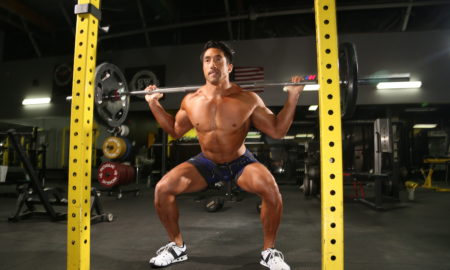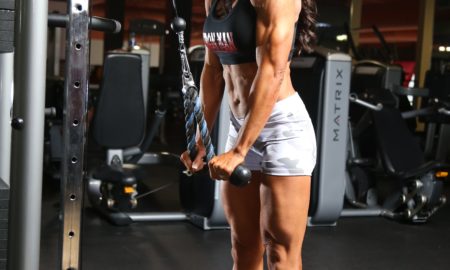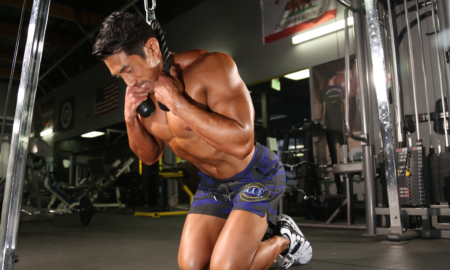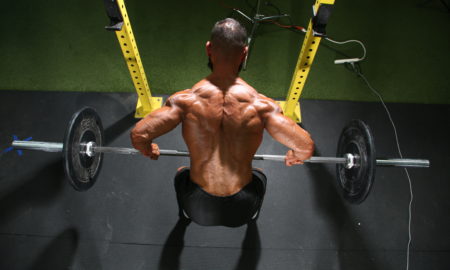Q: I’ve been following your off-season three-day split [from your new e-book] and have made great gains, but I recently broke a finger playing a friendly game of basketball with my buddies. Should I wait until it’s healed to resume my training? I’m worried about losing the muscle I’ve gained over the past year.
A: I certainly understand your concern. I’m a naturally thin person, and if I don’t weight train, I lose muscle very fast. In almost 30 years of serious bodybuilding training the longest I’ve ever gone without lifting is six weeks—and during those six weeks I lost 15 pounds of muscle. There have been a few times when I had both upper- and lower-body injuries at the same time and had to take a couple of weeks off from the weights. I usually drop four to six pounds in just two weeks of not lifting, so my strategy has always been to find ways to work around an injury.
First and foremost you should consult your doctor on when it’s safe to resume weight training. If you just have a hairline fracture and you haven’t done any serious soft-tissue damage, you may be able to get back to the weights in just a few days. If you have a completely broken bone and/or significant soft-tissue damage, you may have to lay off the weights for couple of weeks or more. Again, that’s something that you should ask your physician. The danger of starting back too early is that whenever you have injured tissue, you usually rupture some small blood vessels. That’s why you get discoloration and swelling. During weight training your blood pressure rises dramatically as you exert force against the weight. Even if you’re working a completely different bodypart, if you don’t give those vessels a little time to heal, you can cause more swelling in the injured area just by the elevation in blood pressure. And, more swelling causes the injury to take longer to heal.
That’s why it’s so important to get an ice pack and pressure on an injured area as soon as possible. The cold causes the blood vessels in the affected area to constrict, so there’s less blood and lymphatic fluid leaking around the injury. The pressure applied to the injured area keeps the blood and fluid from collecting there. When you minimize the swelling, your body is able to heal more quickly. So it’s important to avoid a scenario that creates more swelling. Again, consult your physician.
That said, I’ve done a lot of working around injuries during my bodybuilding career, as I have certainly had my share! Unfortunately, I’ve been plagued with tendinitis, muscle tears and even a couple of complete tendon ruptures (a biceps tendon in ’97 and a hamstring tendon in ’07), but my philosophy has always been, 1) I’m gonna come back! and 2) I’m not going to let the rest of my body shrink just because I have an injury.
In ’97 I had the biceps tendon on my right arm reattached on the day before I left for my Christmas vacation. I ended up taking 10 days completely off of training after the surgery. I knew my arm was going to atrophy while in the cast, but I was bound and determined to maintain the muscle in the rest of my body. For the first three weeks postsurgery my right arm was much too painful to move around, so I worked my legs and the left side of my upper body.
After about three weeks the pain subsided, and I added upper-body exercises that I could do with the cast on my arm. I used the pec deck to work my chest, an old-school Nautilus pullover machine to work lats and a lateral-raise machine to work shoulders. I would strap cables to my cast and perform other exercises in order to try to maintain as much muscle as possible on my right side.
My right arm actually atrophied much more than I thought. It shrank four inches during the six weeks in the cast. My chest, shoulder and back also atrophied significantly, but the situation would have surely been worse had I not trained at all. Most important, I was able to maintain the muscle in the rest of my body, and I actually improved my left arm, which had always been a little smaller than the right.
When I got the cast off and got the green light to start training again, I knew that the road back was going to be tough, but I also knew that “muscle memory” would be on my side. The first few days I did curls with a one-pound dumbbell. Then I moved up to a three-pounder. Fortunately for me, Hyde Park Gym has a great set of dumbbells that increase in 2 1/2-pound increments, starting with the five pounders. For a while I was able to move up 2 1/2 pounds every three or four days.
Eight weeks after started training again, I had put 2 1/2 inches back on my arm and was steadily rebuilding the muscle that I lost from the right side of my upper body. Because I had continued to train while in the cast, I was able to guest pose at a show just 10 weeks after my cast came off, and nobody could tell that I’d had an injury.
In 2007, after I ruptured the hamstring tendon, I had surgery to reattach the tendon on a Friday morning, returned to work on Monday and returned to training on Tuesday. People were flabbergasted that I was crutching around the gym, training hard and still dieting. I would tell them, “Hey, I know my left leg is going to shrink. The rest of my body doesn’t have to!”
I had a guest-posing appearance at the NPC Capital of Texas just two weeks after surgery and another at the NPC Ironman Natural in Juneau, Alaska, 12 weeks after that. For the Austin show I came out on two canes and posed with an immobilizer on my left leg. I certainly didn’t want to miss out on the trip to Juneau and I didn’t want to disappoint my fans.
During the first couple of weeks after surgery, I had to make some modifications even on my upper-body exercises. I had to rely more on machines because I wasn’t able to stabilize myself with my legs, and I had to concentrate on keeping the injured hamstring relaxed while I lifted.
Once again, when the doctor told me it was okay to start training my leg again, I only had one lagging -bodypart to bring up. I actually started doing leg extensions and leg curls with no weight at all. I moved up very gradually, as I didn’t want to pull that tendon back off the bone. I used some occlusion training that Layne Norton had written about in IRON MAN, and by the time I did my guest posing, no one could tell that I was just a few months out from a tendon reattachment. In fact, when I mentioned it at the podium, the audience laughed because they thought I was joking!
My main point in these stories is to drive home that you don’t have to let an injury stop you completely. You let the tissue heal up enough to withstand the increase in blood pressure that occurs during lifting without sustaining additional swelling. Then you modify your workouts to work around the injury. Once the injured bodypart is healed and your doctor says it’s okay to start working it again, you work it back very gradually. Because you don’t let everything atrophy, you will be back very close to full size much, much sooner.
In your case, with a broken finger, it’s very likely that you will be able to get back to training in just a matter of days—if it’s just a hairline fracture. You may have to rely on deadlift straps more than usual (I recommend Versa Gripps or Flexsolate cuffs), but that’s okay. During my junior year in high school I played a whole football season with a broken middle finger. We just taped it to my ring finger for support, and off I went (I did drop a lot of passes though.) Be sure to consult your physician. I’m not doctor, nor did I ever play one on TV.
Best of luck with your training! Let me know how it goes.
Train hard and eat clean.
Note: Dave’s new e-book, The Texas Shredder Mass Workout, is now available at www.X-Workouts.com.
Editor’s Note: See Dave Goodin’s blog at www.IronMan
Magazine.com. Click
on the blog selection in the top menu bar.
To contact Dave
directly, send e-mail to TXShredder
@aol.com. IM




















You must be logged in to post a comment Login